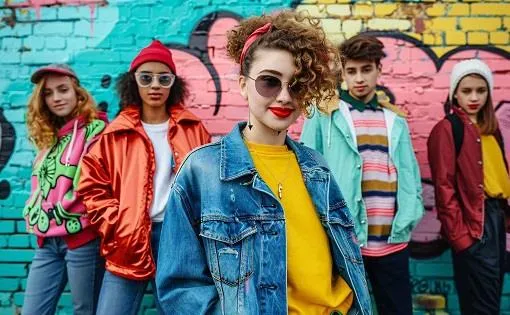Streetwear is a style of casual clothing that has evolved from a niche subculture to a dominant force in the global fashion industry. Its roots can be traced back to the 1970s and 1980s, where it emerged from a fusion of urban subcultures, including:
- Skateboarding and Surf Culture: On the West Coast, particularly in California, the laid-back, anti-establishment attitude of surfers and skaters gave rise to a style of practical and durable clothing. Pioneers like Shawn Stussy, a surfboard shaper, started selling T-shirts with his signature logo, which became a foundational element of the movement.
- Hip-Hop Culture: On the East Coast, the burgeoning hip-hop scene in New York City became a powerful driver of streetwear. Artists like Run-D.M.C. popularized brands like Adidas and Kangol, making tracksuits, sneakers, and bucket hats synonymous with the genre. The do-it-yourself (DIY) aesthetic of punk and the bold graphics of graffiti art also heavily influenced early streetwear.
Key Moments in Streetwear’s Evolution
- 1980s-1990s: The Rise of Core Brands: The era saw the establishment of key brands that defined the genre. Shawn Stussy’s brand, Stüssy, expanded beyond its surf roots to appeal to a wider audience, pioneering a new form of cross-promotion. The late 80s and 90s also saw the rise of brands like Supreme and A Bathing Ape (BAPE), which used strategies like limited-edition drops and scarcity marketing to create hype and exclusivity.
- 2000s: Blurring Lines with Luxury: In the 2000s, the rise of “bling” culture and the popularity of hip-hop brought established luxury brands into the streetwear conversation. Brands like Gucci, Burberry, and Fendi began appearing in music videos, and collaborations between high fashion and streetwear started to emerge.
- 2010s-Present: High Fashion and Mainstream Dominance: Streetwear’s influence exploded in the 2010s, with collaborations becoming a central feature of the industry. Landmark partnerships like Supreme x Louis Vuitton and Virgil Abloh’s appointment as Louis Vuitton’s artistic director for menswear cemented streetwear’s place at the pinnacle of high fashion. Social media and online platforms have also played a crucial role in its democratization, allowing brands to reach a global audience and turning limited-edition “drops” into a cultural phenomenon.
Key Figures and Brands
- Shawn Stussy: The founder of Stüssy, he is often credited as one of the pioneers of streetwear, blending surf and skate culture with a unique, signature logo.
- James Jebbia: The founder of Supreme, he created a brand that cultivated a cult following through a strategic focus on limited releases and a core community.
- Nigo: The founder of A Bathing Ape (BAPE), he brought Japanese streetwear to a global audience with his bold graphics and unique aesthetic.
- Virgil Abloh: The founder of Off-White and artistic director for Louis Vuitton’s menswear, he was instrumental in blurring the lines between streetwear and luxury fashion.
- Dapper Dan: A Harlem couturier from the late 80s, he gained prominence for creating custom, luxury-inspired garments for the hip-hop scene, heavily influencing today’s streetwear.
Today, streetwear continues to evolve, embracing new trends like sustainability, digital fashion, and gender-fluid designs. It remains a powerful symbol of individuality and self-expression, having transformed from a countercultural movement into a global fashion powerhouse.

